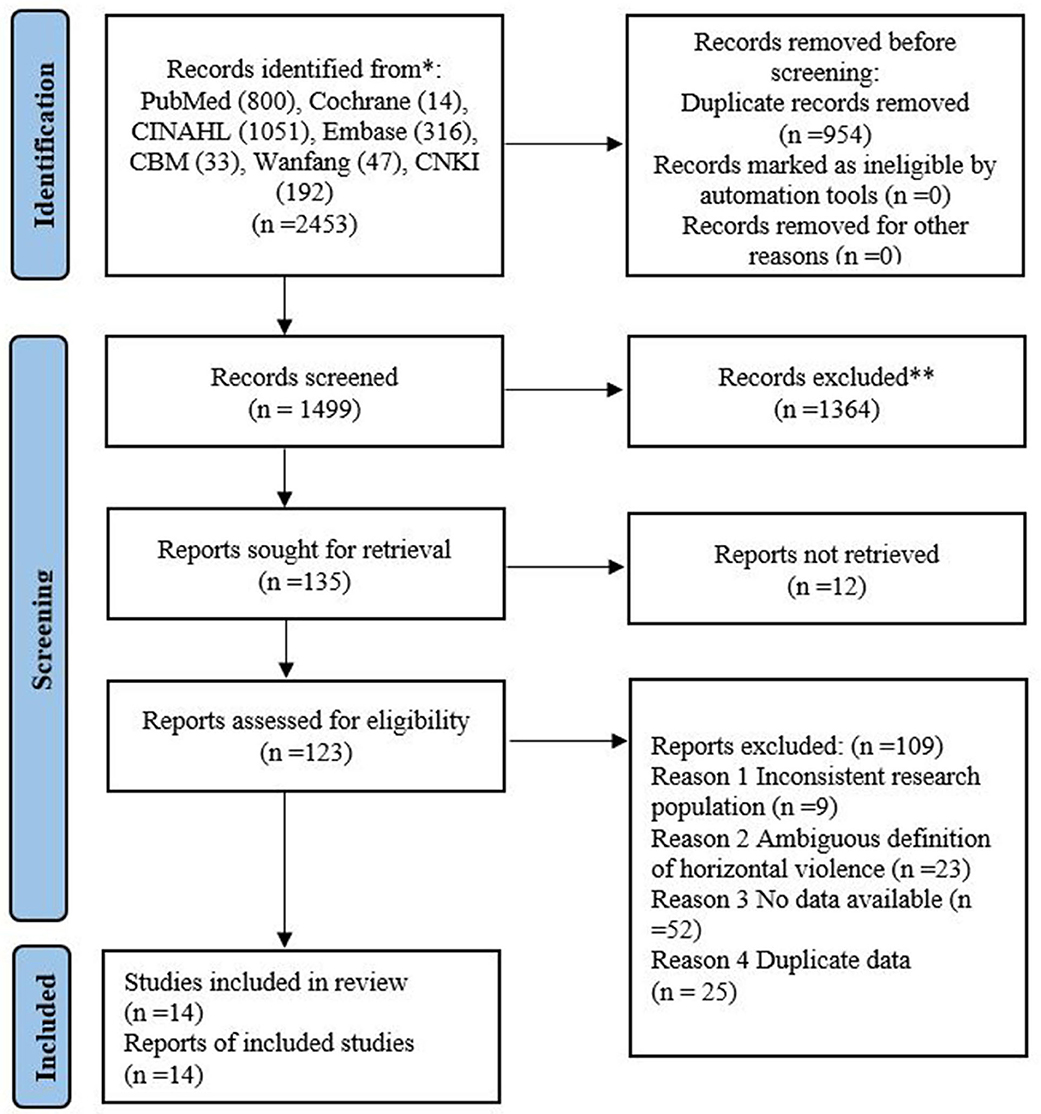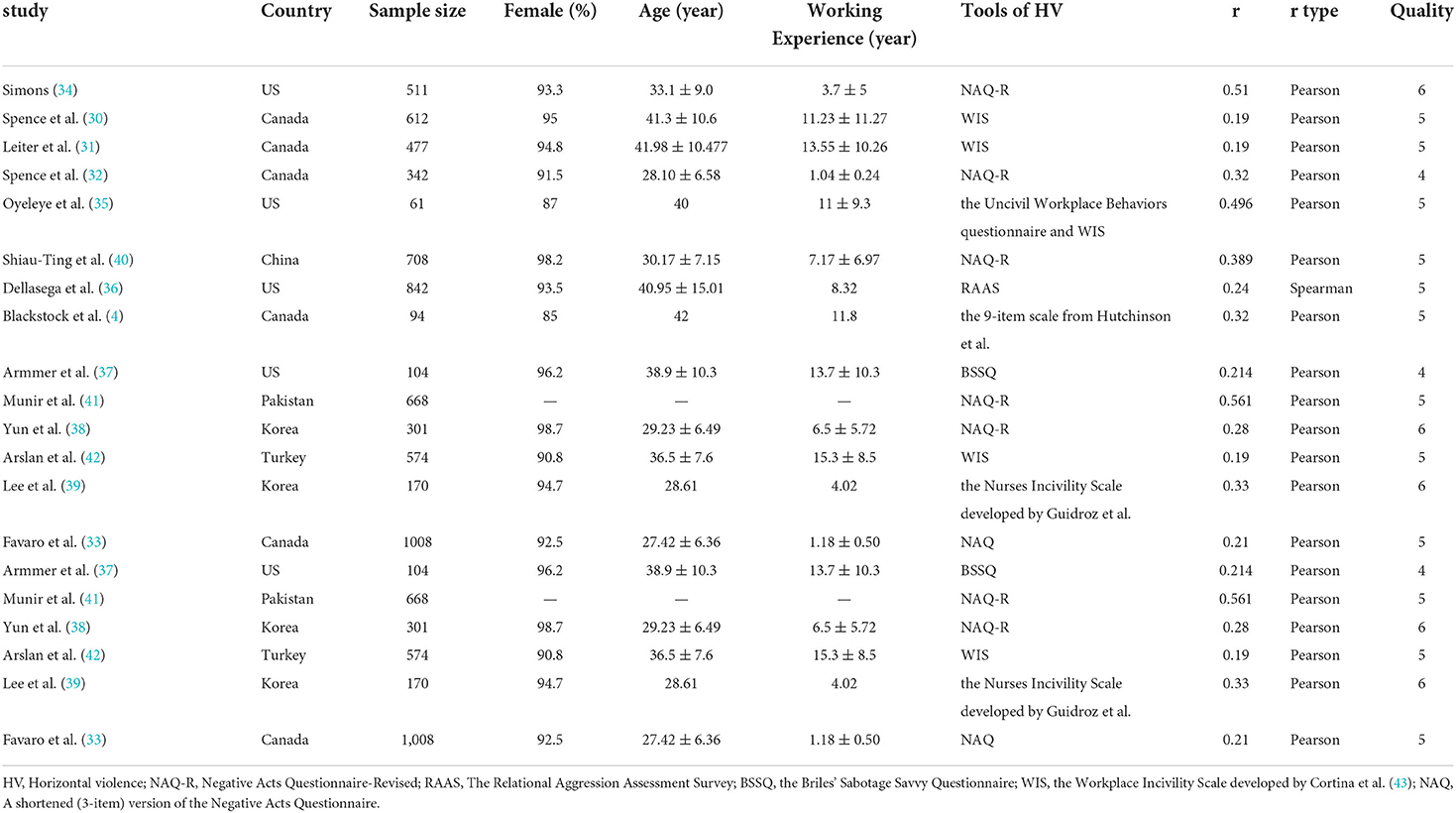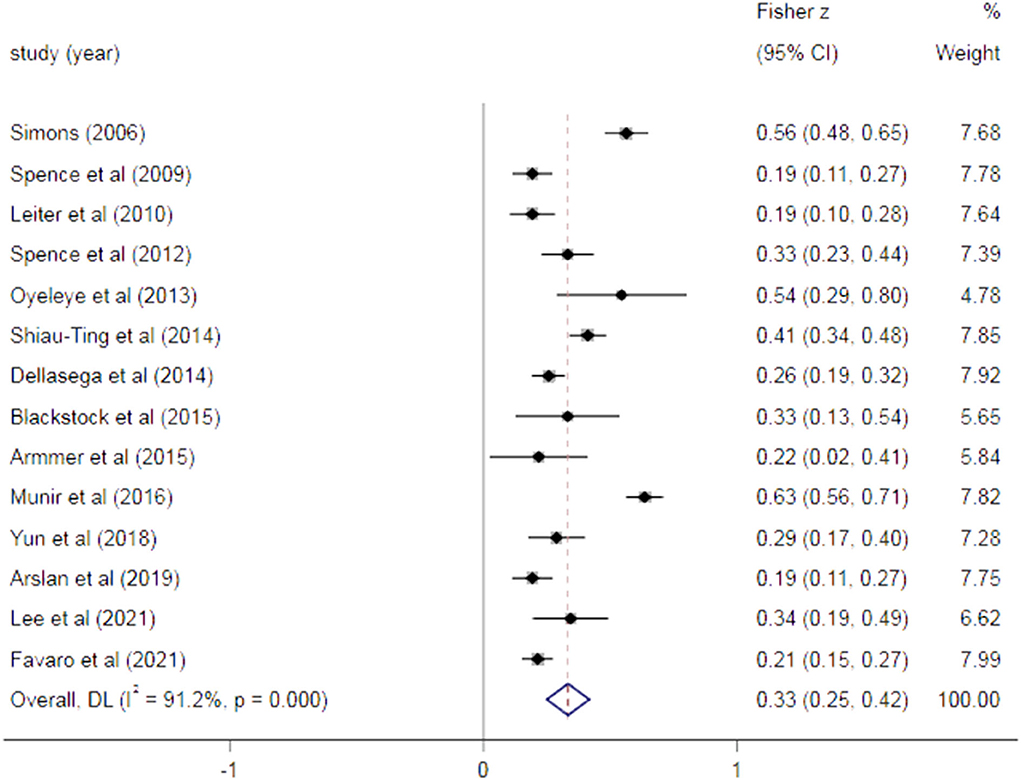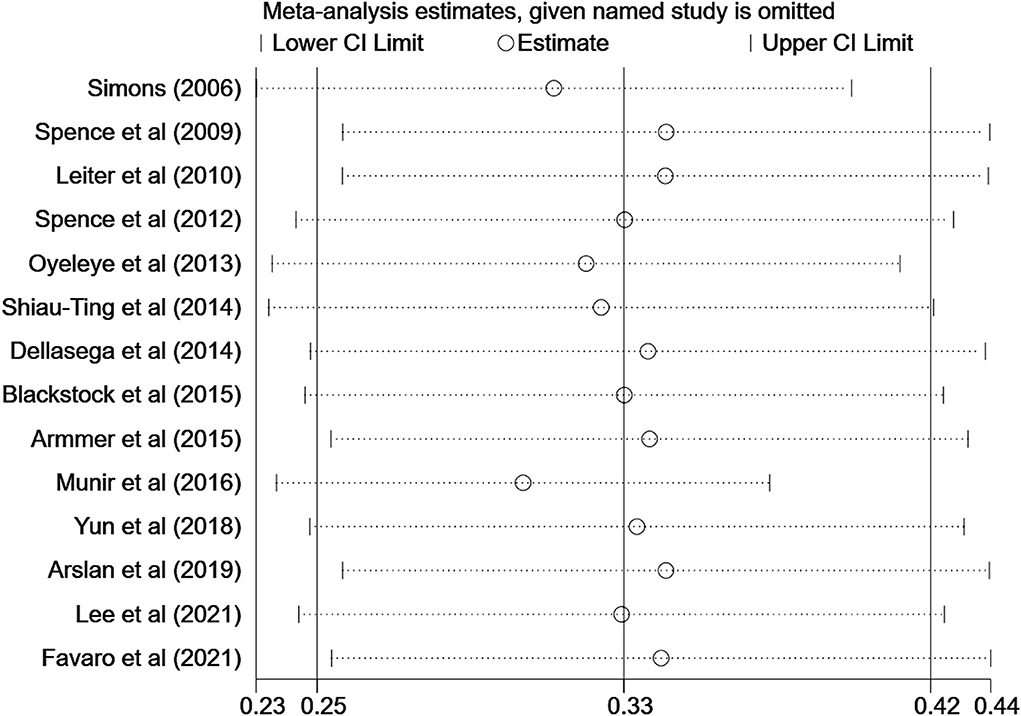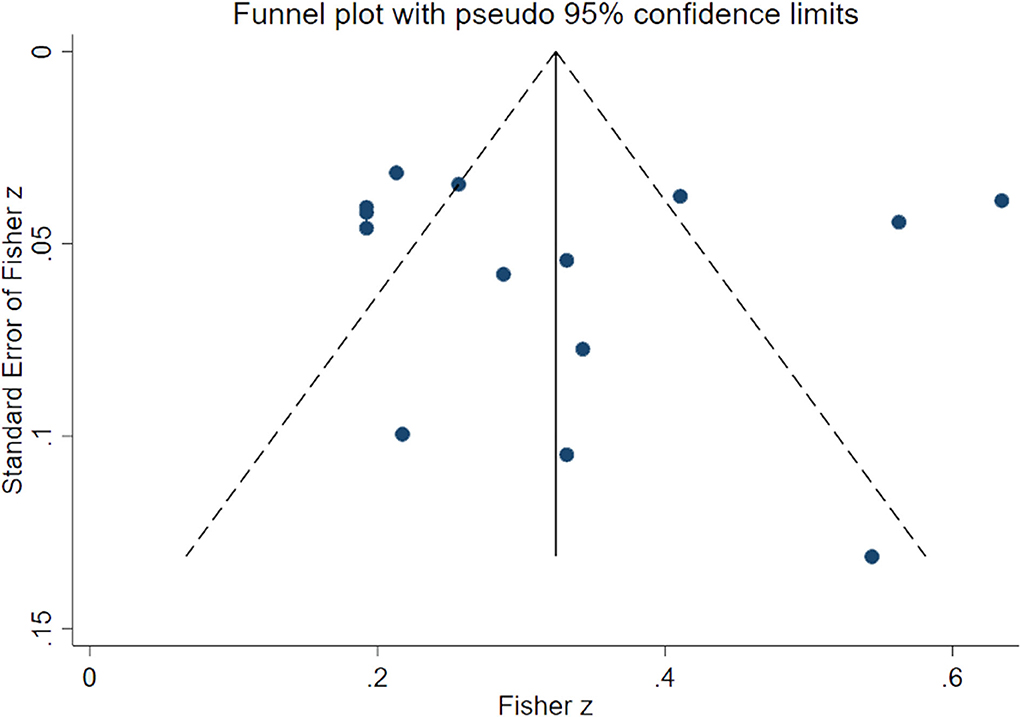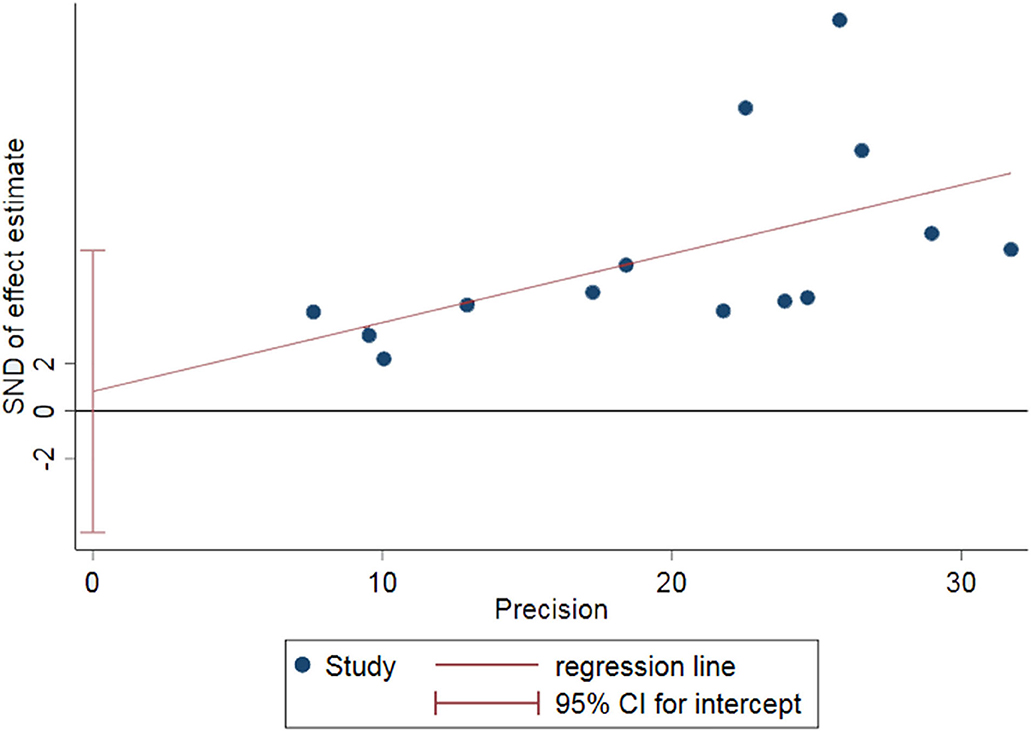- 1Department of Nursing, The First Affiliated Hospital of Soochow University, Suzhou, China
- 2School of Nursing, Medical College of Soochow University, Suzhou, China
- 3Department of Rheumatology, The First Affiliated Hospital of Soochow University, Suzhou, China
- 4Faculty of Nursing, Chiang Mai University, Chiang Mai, Thailand
Background: Horizontal violence is common in nurses. Most published studies have focused on horizontal violence and higher turnover rates in nurses; however, it lacks systematic reviews and meta-analyses. The purpose of this review is to quantitatively assess the correlation between horizontal violence and turnover intention in nurses.
Methods: Systematic review and meta-analysis were performed in accordance with PRISMA guidelines. The relationship between horizontal violence and turnover intention in nurses was obtained by systematically searching related literature in four English databases (Cochrane, PubMed, Embase, and CINAHL) and three Chinese databases (SinoMed, CNKI, and Wanfang) (up to 6 March 2022). The relationship between horizontal violence and turnover intention was evaluated using Fisher's z-value, which was then converted to r. STATA 16.0 was used to perform statistical analysis. The random-effects model was performed to synthesize data.
Results: A total of 14 studies with 6,472 nurses were included. A low-positive correlation of horizontal violence with turnover intention was found (pooled r=0.32 [0.29–0.34]). Subgroup analysis showed that sample size and quality were not the source of heterogeneity. Measurement tool was the source of heterogeneity. Although geographic region might not be the source of heterogeneity, further subgroup analysis of the country reveals heterogeneity. The funnel plot and Egger's test showed no publication bias.
Conclusion: Horizontal violence had a low positive correlation with turnover intention in nurses. Nurses who experienced horizontal violence were more likely to leave or change careers than those who did not experience horizontal violence. This finding helps to draw attention to horizontal violence by nursing managers and implement effective interventions for nurses, so as to reduce nurses' turnover.
Introduction
Horizontal violence (HV), which belongs to internal workplace violence, refers to inter-group conflict, manifested by sabotage, infighting, scapegoating, criticism, and other explicit and implicit non-physical hostilities (1). In the current study, other terms are also used to describe negative behaviors among peers, such as workplace violence, bullying, or workplace incivility (2–4). In recent years, some scholars have made conceptual distinctions between different terms (5). This review focused on the negative behaviors among peers of the same status, without considering the temporal and behavioral differences of negative behaviors. Therefore, horizontal violence is used in this study, and other terms are considered to be forms of horizontal violence. Horizontal violence has many negative effects on nurses. It not only causes negative emotions in nurses (6) and physical symptoms, such as headache and insomnia (7, 8), but also affects the atmosphere of nursing organizations (9, 10) and the quality of nursing work (11). Nurses who have been exposed to horizontal violence for a long time may have the leave intention (12). Currently, sufficient evidence showed that turnover intention is the direct premise of turnover behavior (13). As a high turnover rate has many adverse effects on nurses' own development, nursing quality, patient outcomes, medical organization stability, and other aspects, it has been a wide concern among scholars and nursing managers (14). In conclusion, turnover intention, as an adverse outcome of horizontal violence, is a huge obstacle in nursing career development, and it is necessary to think highly of the association between the two aspects.
Turnover intention, which refers to the tendency of employees to leave their current job and seek other job opportunities, is a key predictor of turnover although it does not necessarily lead to actual turnover (15). Frequent employee turnover reduces organizational efficiency, may cause emotional instability and slack behavior of other employees in the organization, and increases the hospital's investment in nurse training (16). In the case of a shortage of nurses, finding the factors that affect nurses' turnover intention and reducing nurses' turnover intention are the main issues that researchers need to consider.
Current research showed that the reasons for nurses' resignation include salary, negative working environment, excessive workload, and inconsistency with personal expectations (17, 18). However, it is difficult to substantially improve nurses' salaries, reduce their workload and change their social status in the short term. Scholars mostly put forward strategies to reduce nurses' turnover intention from the perspective of improving the organizational atmosphere and providing a healthy working environment (18). In the context of workplace violence, scholars pay more attention to the high prevalence of violence between nurses and patients and pay less attention to the negative behavior between colleagues. As a result, there are still some nurses who lack awareness of horizontal violence and lack the ability to effectively deal with it, so they choose negative coping methods, such as silence and compromise. When it exceeds the tolerance of nurses, they will have the intention to leave or change careers. Bambi et al. (19) showed that in 87.4% of nurses exposed to horizontal violence, as many as 75% showed physical and psychological symptoms, and about 10% showed symptoms of post-traumatic stress disorder. Some junior nurses chose to leave or even change careers due to horizontal violence. Other studies showed that inter-nurse horizontal violence is one of the most destructive problems affecting nursing career development, and nurses often deal with horizontal violence in negative ways such as resignation, retaliation, avoidance, and turnover intention (12). A study occurred in China showed that the prevalence of horizontal violence among nurses is about 56.6%, among which 21.67% are nurses with turnover intention and 33.33% are nurses with change careers intention (20). A multi-center study from the USA showed that 43–46% of participants indicated that horizontal violence did not impact their intention to leave, but 11–16% felt horizontal violence impacted their intention (21).
In conclusion, most studies indicate that horizontal violence is associated with turnover intention, but the proportion of turnover intention varies among studies, and the degree of correlation between horizontal violence and turnover intention is unclear. To date, no meta-analysis has been published on the association between horizontal violence and turnover intention. Therefore, in view of this situation, we conducted a systematic review and meta-analysis to gather the available evidence and more accurately evaluate the correlation between horizontal violence and turnover intention in nurses, so as to provide a recommendation to pay attention to horizontal violence, investigate antecedents, and implement strategies to reduce nurses' turnover intention.
Materials and methods
Search strategy
This systematic review and meta-analysis were carried out according to the Preferred Reporting Items for Systemic Review and Meta-Analyses (PRISMA 2020) guidelines (22). A systematic search was performed in the four English databases: Cochrane Library, PubMed, EMBASE, and CINAHL, and three Chinese databases: SinoMed, CNKI, and Wanfang (from inception to March 6, 2022). Keywords used for searching were “horizontal violence” (including “lateral violence”, “horizontal hostility”, “bullying place”, and “workplace incivility”) and nurses, with the retrieval adjusted according to the database, the search strategy is shown in Supplementary File 1. In addition, the list of references in the included articles was searched to obtain additional studies.
Inclusion criteria
Inclusion criteria were: (1) The participants were nurses, and the violent behavior was from colleagues; (2) investigating the relationship between horizontal violence and turnover intention; (3) reporting data on the correlation between horizontal violence and turnover intention, including Spearman's or Pearson's correlation coefficient (r); (4) research design was cross-sectional, case-control, or longitudinal design (using baseline data); and (5) published in English and Chinese.
Exclusion criteria
Exclusion criteria were: (1) meeting or conference abstracts, case reports, reviews, meta-analysis, letters, pilot studies, qualitative studies, and study protocols; (2) full-text studies not found; (3) duplicate articles and/or data (selected the most recent article); and (4) unclear descriptions of nurse populations and data.
Data extraction and quality assessment
Two reviewers screened the literature independently according to the inclusion and exclusion criteria. After confirming the included studies, the two authors independently extracted data from each paper, including the first author, year of publication, country, sample size and percent of females, age, working experience, tools of horizontal violence, and Pearson's/Spearman's correlation coefficient (r) between horizontal violence and turnover intention. The quality of the included studies was evaluated using the modified Newcastle-Ottawa Scale (M-NOS) (23). There are eight items and a maximum of 10 stars. The higher scores indicate better quality. In this study, ≥5 was defined as low-risk bias and <5 as high-risk bias. Any disagreements between two authors, which cannot be resolved through discussion, should be discussed and adjudicated by the third author.
Statistical analysis
Stata 16.0 was used for meta-analysis. The random-effects model was used as a synthesizer, as it is more desirable than the fixed-effects model and can provide a wider confidence interval (CI). For correlation coefficients (r), Spearman's r was first converted to Pearson's r (24). Then the pooled estimate of Pearson's r by Fisher's exact test r-to-z transformation was calculated (25). All values were weighted by the reciprocal of the r variance, after which the combined r of the overall value was converted back for presentation. I2 was adopted to assess between-study heterogeneity, with thresholds of 25% (low heterogeneity), 50% (moderate heterogeneity), and 75% (high heterogeneity) (26). Subgroup and sensitivity analyses were used to search for sources of heterogeneity. Funnel plots and Egger's test were only combined to assess publication bias when ≥10 studies were included (27, 28), as the power of these tests is too low to distinguish chance from real asymmetry when there are <10 studies (29).
Results
Study selection
After having assessed the studies by selection criteria, data from 14 studies were included, which involved 6,472 nurses. A flow chart of the study selection process is shown in Figure 1.
Study characteristics
In this systematic review and meta-analysis, five studies occurred in Canada (4, 30–33), four in America (34–37), two in Korea (38, 39), and one in each of the following countries: China (40), Pakistan (41), and Turkey (42). Ten studies had large sample sizes (≥200 cases) and the others were small sample sizes (<200 cases). NAQ-R scale was most commonly used to measure horizontal violence (five studies), following the WIS scale (three studies). Measuring the quality of studies by M-NOS (0–5 scores), two studies were judged as the high risk of bias (<3 points), and the others were judged as the low risk of bias (≥3 points). Details are shown in Table 1.
Correlation between horizontal violence and turnover intention in nurses
As shown in Figure 2 14 studies reported a correlation (r) between horizontal violence and turnover intention among nurses, and the pooled Fisher z-value was 0.33 (95% CI: 0.25–0.42; I2 = 91.2%, P < 0.001). After the z-to-r back transformation, the pooled r was 0.32 (95% CI: 0.29–0.34; P < 0.001), and 95% CI (0.24–0.39) does not include the value 0, suggesting a positive relationship between the horizontal violence and turnover intention, and the correlation magnitude is lower.
Subgroup analysis
Subgroup analysis was conducted based on geographic region, sample size, measurement tools of horizontal violence, and quality. The results showed that measurement tools may be the source of heterogeneity in the meta-analysis of the correlation between horizontal violence and turnover intention. Subgroup analysis showed that the pooled Fisher z-value was 0.45 (95%CI: 0.32–0.58) for NAQ-R, which suggests a low-positive relationship. However, WIS and Others were 0.19 (95%CI: 0.14–0.24) and 0.27 (95%CI: 0.21–0.34), respectively, showing that horizontal violence was not associated with turnover intentions. Geographical regions are further divided into subgroups of countries (US, Canada, and Korea), and heterogeneity is found. The results showed that the pooled Fisher z-value was 0.39 (0.19, 0.59) in the USA and 0.31 (0.22, 0.40) in Korea, suggesting a low correlation between horizontal violence and turnover intention. In Canada, it was 0.23 (0.18, 0.28), suggesting no correlation (Supplementary File 2).
Sensitivity analysis and publication bias
Although the quality of the two studies was assessed as high risk, both sensitivity analysis and subgroup analysis showed no significance, indicating that the risk of bias was not related to study quality, so two low-quality studies were still included in the meta-analysis. Sensitivity analysis was conducted on the included 14 studies, and it was found that the results were unchanged when each study was excluded serially (Figure 3). It indicated that the results of this meta-analysis were stable. Funnel plots and Egger's test indicated that no significant evidence of publication bias was found in the 14 studies (Egger bias = 0.82, 95% CI: (−5.09, 6.73), P = 0.767) (Figures 4, 5).
Discussion
This systematic review and meta-analysis quantitatively assessed the association between horizontal violence and turnover intention in nurses. As far as we know, the review included 14 studies involving 6,472 nurses and was the first quantitative assessment of the association between horizontal violence and turnover intention. The results of the random-effects meta-analysis procedure show that there is a positive correlation between horizontal violence and turnover intention in nurses.
Subgroup analysis of the geographic region, sample size, horizontal violence measurement tools, and quality showed that only horizontal violence measurement tools might be the source of heterogeneity (P = 0.001). NAQ-R (Fisher z = 0.45; Z = 6.901, P < 0.001) showed a stronger correlation between horizontal violence and turnover intention than WIS (Fisher z = 0.19; Z = 7.822, P < 0.001) and Others (Fisher z = 0.27; Z = 8.178, P < 0.001). The results showed that horizontal violence associated with turnover intention in Asia (Fisher z = 0.38; Z = 4.406, P < 0.001) was stronger than that in America (Fisher z = 0.30; Z = 6.510, P < 0.001), but there was no statistical significance between groups (P = 0.463). Further divided by different countries (USA, Canada, and Korea) into subgroups, heterogeneity was found among different countries (P < 0.001): USA (Fisher z = 0.39; Z = 3.792, P < 0.001), followed by Korea (Fisher z = 0.31; Z = 6.631, P < 0.001). The Canada correlation was considered almost irrelevant (Fisher z = 0.23; Z = 8.728, P < 0.001). It suggested that the correlation between horizontal violence and turnover intention was different in countries, which might be related to the cultural environment. Influenced by cultural differences, individuals may react differently to violent acts (13). As suggested by Sorge et al. (44), the extent to which members of a specific culture can control their desires and impulses is one of the influential dimensions used to classify that culture. Workplace incivility tends to be higher in “indulgent” cultures (such as the USA), while “restrained” cultures (such as Mediterranean countries) have weaker impulse control (44). Lutgen et al. (45) noted that in individualistic cultures, such as the USA, the individual may feel more threatened by bullying and more challenged by bullying events since they may perceive bullying as an attempt to weaken their competitive strength. In the context of collectivism, for example, in Asian countries, such as China and Japan, harmony and group norms are more valuable, which may lead nurses to choose to avoid or even get used to their negative emotions after experiencing bullying and return to their previous level of well-being after a period of time (46). It should be noted that the number of studies included in this meta-analysis was insufficient, and there was insufficient evidence for a pooled analysis when conducting subgroup analysis. Therefore, it is suggested that researchers should conduct more comparative studies on cultural differences in the future. In addition, the correlation measured by the NAQ-R measurement tool was significantly higher than that of the other two groups (Fisher z = 0.45; Z = 6.901, P < 0.001). WIS (Fisher z = 0.19; Z = 7.822, P < 0.001) and Others (Fisher z = 0.27; Z = 8.178, P < 0.001) showed almost no correlation between horizontal violence and turnover intention. This may be related to NAQ-R's sensitivity to horizontal violence. Currently, NAQ-R is the main measurement tool used to measure horizontal violence. Among the 14 studies included in this review, it can also be found that there are six studies (32–34, 38, 40, 41) used NAQ-R, one of which is the third edition of NAQ (33), and three of the five studies after 2015 have used this measurement tool. It is suggested that researchers conduct controlled trials to further explore the differences in horizontal violence measured with different measurement tools in the future.
The advantage of this systematic review and meta-analysis include: previous studies have inconsistent conclusions on the correlation between horizontal violence and turnover intention in nurses, while this review, including 6,472 nurses, has a large sample size and a relatively firm conclusion. Through sensitivity analysis and heterogeneity test, it was finally confirmed that the result was stable. Therefore, it can provide reference for future nursing managers to pay attention to horizontal violence, implement intervention measures and reduce the turnover intention of nurses. In addition, a meta-analysis showed a pooled r-value of 0.32 (95% CI: 0.29–0.34; P < 0.001), and there was a low-positive correlation between nurses' horizontal violence and turnover intention. Horizontal violence has been shown to be one of the reasons nurses leave their jobs. It is suggested that nurse managers should not only pay attention to the improvement of nurses' professional ability and the prevention of nurse-patient conflict, but also pay attention to the impact of negative behavior among colleagues on nurses, and explore strategies to improve horizontal violence.
This meta-analysis has the following limitations. First, the number of studies included in this meta-analysis is small, and the number of subgroup analysis studies is insufficient. For example, the studies are limited to Asia and America, there are no studies from other regions due to some reasons, which limits the representativeness of the results. So, it is recommended that studies on the correlation between horizontal violence and turnover intention be carried out in more regions and that meta-analysis results must be updated to better represent global levels. Second, the outcomes caused by horizontal violence are not limited to turnover intention. Although most studies suggest that a higher turnover rate is related to horizontal violence, this study suggests a low correlation. In recent years, with the development of structural equation modeling, more and more studies have focused on the mechanism between them. Therefore, it is suggested to explore the relationship between horizontal violence and other outcomes in the future and explore variables that may play a mediating or moderating effect between horizontal violence and turnover intention. Finally, we tried our best to have a rigorous attitude for screening and analysis of interpretation of the study, but the research mainly was a cross-sectional design. Horizontal violence and turnover intention at the same time measurement may lead to the possibility of a spurious correlation. So, there is a need for more longitudinal studies, which can further explain the correlation between horizontal violence and turnover intention.
Conclusion
This meta-analysis suggests that horizontal violence has a low-negative correlation with turnover intention in nurses. Nurses who have experienced horizontal violence tend to be more likely to leave their jobs than those who have not experienced horizontal violence. Awareness of this correlation may prompt nursing managers to pay more attention to horizontal violence, care about how nurses get along with colleagues, and strive to create a good working atmosphere, thereby reducing nurse turnover.
Data availability statement
The original contributions presented in the study are included in the article/Supplementary material, further inquiries can be directed to the corresponding author/s.
Author contributions
YZ and JL searched and checked the databases according to the inclusion and exclusion criteria, extracted the data, and assessed their quality. YZ analyzed the data and wrote the draft of the paper. RY and JC gave advice on meta-analysis methodology and revised the paper. LM is the guarantor of this work and had full access to all the data in the study and takes responsibility for its integrity and the accuracy of the data analysis. All authors contributed to reviewing, read, and approved the final manuscript.
Funding
The authors received financial support from the National Natural Science Foundation of China (Grant No. 71874117).
Acknowledgments
We would like to thank Yixiu Liu and Huanqing Dong for their great assistance in translation.
Conflict of interest
The authors declare that the research was conducted in the absence of any commercial or financial relationships that could be construed as a potential conflict of interest.
Publisher's note
All claims expressed in this article are solely those of the authors and do not necessarily represent those of their affiliated organizations, or those of the publisher, the editors and the reviewers. Any product that may be evaluated in this article, or claim that may be made by its manufacturer, is not guaranteed or endorsed by the publisher.
Supplementary material
The Supplementary Material for this article can be found online at: https://www.frontiersin.org/articles/10.3389/fpubh.2022.964629/full#supplementary-material
References
1. Yuqin C, Yilan L, Hongwei C, Xiao P, Rui C, Fengjian Z. Visualization analysis of horizontal violence in nurses based on CiteSpace. J Nurs Sci. (2021) 36:64–7.
2. Spence Laschinger HK, Read EA. The effect of authentic leadership, person-job fit, and civility norms on new graduate nurses' experiences of coworker incivility and burnout. JONA. (2016) 46:574–80. doi: 10.1097/NNA.0000000000000407
3. Purpora C, Blegen MA. Job satisfaction and horizontal violence in hospital staff registered nurses: the mediating role of peer relationships. J Clinical Nurs. (2015) 24:2286–94. doi: 10.1111/jocn.12818
4. Blackstock S, Harlos K, Macleod MLP, Hardy CL. The impact of organisational factors on horizontal bullying and turnover intentions in the nursing workplace. J Nurs Manage. (2015) 23:1106–14. doi: 10.1111/jonm.12260
5. Wright W, Khatri N. Bullying among nursing staff: Relationship with psychological/behavioral responses of nurses and medical errors. Health Care Manage R. (2015) 40:139–47. doi: 10.1097/HMR.0000000000000015
6. Homayuni A, Hosseini Z, Aghamolaei T, Shahini S. Which nurses are victims of bullying: the role of negative affect, core self-evaluations, role conflict and bullying in the nursing staff. BMC Nurs. (2021) 20:1–9. doi: 10.1186/s12912-021-00578-3
7. Bambi S, Guazzini A, Piredda M, Lucchini A, De Marinis MG, Rasero L. Negative interactions among nurses: An explorative study on lateral violence and bullying in nursing work settings. J Nurs Manage. (2019) 27:749–57. doi: 10.1111/jonm.12738
8. KO Y, LIU Y, WANG C, LIAO H, LIAO Y, CHEN H. Determinants of Workplace Bullying Types and Their Relationship With Depression Among Female Nurses. J Nurs Res. (2020) 28:e92. doi: 10.1097/JNR.0000000000000367
9. Peng X, Gan Y, Zeng Q, Xiong L, Zhang F, Xiong H, et al. Nurse-to-nurse horizontal violence in Chinese hospitals and the protective role of head nurse's caring and nurses' group behavior on it: A cross-sectional study. J Nurs Manage. (2021). doi: 10.1111/jonm.13498
10. Doo EY, Choi S. Effects of horizontal violence among nurses on patient safety: Mediation of organisational communication satisfaction and moderated mediation of organisational silence. J Nurs Manage. (2021) 29:526–34. doi: 10.1111/jonm.13182
11. Lewis Pierre L, Anglade D, Saber D, Gattamorta KA, Piehl D. Evaluating horizontal violence and bullying in the nursing workforce of an oncology academic medical center. J Nurs Manage. (2019) 27:1005–10. doi: 10.1111/jonm.12763
12. Small MM, Lindo J, Aiken J, Chin C. Lateral violence among nurses at a Jamaican hospital : a mixed methods study. Int J Adv Nurs Stud. (2017) 6:85–91. doi: 10.14419/ijans.v6i2.8264
13. Namin BH, Øgaard T, Røislien J. Workplace incivility and turnover intention in organizations: a meta-analytic review. Int J Environ Res Public Health. (2021) 19:102599. doi: 10.3390/ijerph19010025
14. Yang F, Xue B, Pengqian F. Thinking on the key development fields and paths of nursing during the “14th Five-Year Plan” period in China. Chin Hosp. (2021) 25:6–9.
15. Djupedal I, Pallesen S, Harris A, Waage S, Bjorvatn B, Vedaa Ø. Changes in the work schedule of nurses related to the COVID-19 pandemic and its relationship with sleep and turnover intention. Int J Environ Res Public Health. (2022) 19:8682. doi: 10.3390/ijerph19148682
16. Chu X, Zhang L, Li M. Nurses' strengths use and turnover intention: the roles of job crafting and self-efficacy. J Adv Nurs. (2022) 78:2075–84. doi: 10.1111/jan.15124
17. Çamveren H, Arslan Yürümezoglu H, Kocaman G. Why do young nurses leave their organization? A qualitative descriptive study. Int Nurs Rev. (2020) 67:519–28. doi: 10.1111/inr.12633
18. Zhang W, Wu S, Chen X, et al. Mediating effect of job burnout between perceived supervisor support and turnover intention of nurses in a Class? Grade A hospital. Chinese Health Resour. (2021) 2:787–91. doi: 10.13688/j.cnki.chr.2021.210346
19. Bambi S, Foà C, De Felippis C, Lucchini A, Guazzini A, Rasero L. Workplace incivility, lateral violence and bullying among nurses. A review about their prevalence and related factors. Acta Biomedica. (2018) 89:51–79. doi: 10.23750/abm.v89i6-S.7461
20. Ying F, Mengting J, Qi W, Lu T, Fang W, Chunyan W. Status, reason analysis and coping strategy discussion on lateral violence among emergency department nurses. Chin J Pract Nurs. (2018) 34:222–7.
21. Hopkinson SG, Dickinson CM, Dumayas JY, Jarzombek SL, Blackman VS. A multi-center study of horizontal violence in United States military nursing. Nurse Educ Pract. (2020) 47:102838. doi: 10.1016/j.nepr.2020.102838
22. Moher D, Liberati A, Tetzlaff J, Altman DG. Preferred reporting items for systematic reviews and meta-analyses: the PRISMA statement. PLoS Med. (2009) 6:e1000097. doi: 10.1371/journal.pmed.1000097
23. Stang A. Critical evaluation of the Newcastle-Ottawa scale for the assessment of the quality of nonrandomized studies in meta-analyses. Eur J Epidemiol. (2010) 25:603–5. doi: 10.1007/s10654-010-9491-z
24. Rupinski MT, Dunlap WP. Approximating Pearson Product-Moment Correlations from Kendall's Tau and Spearman's Rho. Educ Psychol Meas. (1996) 56:419–29. doi: 10.1177/0013164496056003004
25. Haddock WRSC. Combining estimates of effect size. The handbook of research synthesis and meta-analysis. (2009) 2009:257.
26. Higgins JP, Thompson SG, Deeks JJ, Altman DG. Measuring inconsistency in meta-analyses. BMJ. (2003) 327:557–60. doi: 10.1136/bmj.327.7414.557
27. Sterne JA, Egger M. Funnel plots for detecting bias in meta-analysis: guidelines on choice of axis. J Clin Epidemiol. (2001) 54:1046–55. doi: 10.1016/S0895-4356(01)00377-8
28. Egger M, Smith GD, Schneider M, Minder C. Bias in meta-analysis detected by a simple, graphical test. Bmj. (1997) 315:629–34. doi: 10.1136/bmj.315.7109.629
29. Abhyankar A, Ham M, Moss AC. Meta-analysis: the impact of disease activity at conception on disease activity during pregnancy in patients with inflammatory bowel disease. Aliment Pharm Ther. (2013) 38:460–6. doi: 10.1111/apt.12417
30. Spence LH, Leiter M, Day A, Gilin D. Workplace empowerment, incivility, and burnout: impact on staff nurse recruitment and retention outcomes. J Nurs Manag. (2009) 17:302–11. doi: 10.1111/j.1365-2834.2009.00999.x
31. Leiter MP, Price SL, Laschinger H. Generational differences in distress, attitudes and incivility among nurses. J Nurs Manage. (2010) 18:970–80. doi: 10.1111/j.1365-2834.2010.01168.x
32. Spence Laschinger HK, Wong CA, Grau AL. The influence of authentic leadership on newly graduated nurses' experiences of workplace bullying, burnout and retention outcomes: a cross-sectional study. Int J Nurs Stud. (2012) 49:1266–76. doi: 10.1016/j.ijnurstu.2012.05.012
33. Favaro A, Wong C, Oudshoorn A. Relationships among sex, empowerment, workplace bullying and job turnover intention of new graduate nurses. J Clin Nurs. (2021) 30:1273–84. doi: 10.1111/jocn.15671
34. Simons SR. Workplace Bullying Experienced by Nurses Newly Licensed in Massachusetts and the Relationship to Intention to Leave the Organization. Boston: University of Massachusetts (2006). p. 143.
35. Oyeleye O, Hanson P, O'Connor N, Dunn D. Relationship of workplace incivility, stress, and burnout on nurses' turnover intentions and psychological empowerment. JONA. (2013) 43:536–42. doi: 10.1097/NNA.0b013e3182a3e8c9
36. Dellasega C, Volpe RL, Edmonson C, Hopkins M. An Exploration of Relational Aggression in the Nursing Workplace. JONA. (2014) 44:212–8. doi: 10.1097/NNA.0000000000000052
37. Armmer F, Ball C. Perceptions of horizontal violence in staff nurses and intent to leave. Work. (2015) 51:91–7. doi: 10.3233/WOR-152015
38. Yun S, Kang J. Influencing factors and consequences of workplace bullying among nurses: a structural equation modeling. Asian Nurs Res. (2018) 12:26–33. doi: 10.1016/j.anr.2018.01.004
39. Lee YH, Lee J, Lee SK. The mediating effect of workplace incivility on organization culture in South Korea: a descriptive correlational analysis of the turnover intention of nurses. J Nurs scholarship. (2021). doi: 10.1111/jnu.12734
40. Shiau-Ting T, Chin-Hua H, Li-Fang C, Fan-Hao C. Nursing workplace bullying and turnover intention: an exploration of associated factors at a medical center in Southern Taiwan. J Nurs. (2014) 61:58–68. doi: 10.6224/JN.61.3.58
41. Munir Y, Ghafoor MM, Rasli AM. Exploring the relationship of horizontal violence, organizational cynicism and turnover intention in the context of social exchange theory. Int J Human Rights Healthcare. (2016) 9:254–66. doi: 10.1108/IJHRH-08-2016-0014
42. Arslan Yürümezoglu H, Kocaman G. Structural empowerment, workplace incivility, nurses' intentions to leave their organisation and profession: a path analysis. J Nurs Manage. (2019) 27:732–9. doi: 10.1111/jonm.12751
43. Cortina LM, Magley VJ, Williams JH, Langhout RD. Incivility in the workplace: incidence and impact. J Occup Health Psychol. (2001) 6:64–80.
44. Sorge A. Culture's Consequences: International Differences in Work-Related Values. JSTOR. (1983). doi: 10.2307/2393017
45. Lutgen Sandvik P, Tracy SJ, Alberts JK. Burned by bullying in the American workplace: Prevalence, perception, degree and impact. J Manage Stud. (2007) 44:837–62. doi: 10.1111/j.1467-6486.2007.00715.x
Keywords: horizontal violence, turnover intention, nurses, occupational health, meta-analysis
Citation: Zhang Y, Yin R, Lu J, Cai J, Wang H, Shi X and Mao L (2022) Association between horizontal violence and turnover intention in nurses: A systematic review and meta-analysis. Front. Public Health 10:964629. doi: 10.3389/fpubh.2022.964629
Received: 08 June 2022; Accepted: 12 September 2022;
Published: 06 October 2022.
Edited by:
David Peters, University of Westminster, United KingdomReviewed by:
Charlie Falguera, University of the Philippines Manila, PhilippinesFeifei Sun, Shandong Mental Health Center, China
Copyright © 2022 Zhang, Yin, Lu, Cai, Wang, Shi and Mao. This is an open-access article distributed under the terms of the Creative Commons Attribution License (CC BY). The use, distribution or reproduction in other forums is permitted, provided the original author(s) and the copyright owner(s) are credited and that the original publication in this journal is cited, in accordance with accepted academic practice. No use, distribution or reproduction is permitted which does not comply with these terms.
*Correspondence: Lifen Mao, bWFvbGlmZW44NDA0QDE2My5jb20=
 Yue Zhang1,2
Yue Zhang1,2 Xiaoqing Shi
Xiaoqing Shi Lifen Mao
Lifen Mao